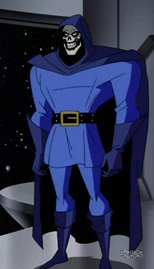Fictional character biography
Doctor Destiny is a petty criminal scientist who uses his genius to create astounding devices for crime. He first encounters the Justice League of America shortly after inventing an anti-gravity device and will-deadener beam that allow him to capture and impersonate Green Lantern. [5] Before Destiny can further his criminal ends, the League discovered his treachery as Green Arrow had heard from an underworld informant that a member of the League had been captured and was being impersonated. Destiny captures the League and attempts to get rid of them by sending the ship they are on into space. As Destiny is drawing the JLA upwards, the station suffers a brief power drain, lessening the effects of the will-deadener. Green Lantern frees himself and imprisons Destiny and his two henchmen.
Morpheus
Destiny creates the "Materioptikon", a device which allows him to manifest the fabric of dreams into reality. [6] A later retcon in The Sandman reveals that the Materioptikon is powered by Morpheus' Dreamstone, which was given to Destiny by his mother Ethel. Destiny manipulated the Dreamstone, forcing flaws and adding circuitry, until it was attuned to him rather than Morpheus. [4]
Doctor Destiny's power becomes so great that the Justice League resort to drastic measures to stop him. They hypnotize him and manipulate his psyche to prevent him from dreaming. This prevents Destiny from using the Materioptikon, but causes him to lose his mind and shrivel to a skeletal form. Destiny is sent to Arkham Asylum, where his sanity erodes further. [4] [7]
Following the death of his mother, Destiny escapes Arkham, makes his way to a diner, and tortures the patrons over the course of 24 hours before having them kill each other. Dream, recently freed and searching for stolen tokens of power, is unable to stop Destiny until the Dreamstone is destroyed, which returns its power to Dream. Morpheus returns Destiny to Arkham and restores his ability to dream. [8] Despite the Dreamstone's destruction, Destiny's continued use of the Materioptikon allows him to retain a portion of its powers. [9]
Dawn of DC
In the Knight Terrors event, it is revealed that the Nightmare Stone utilized by Insomnia was once the Dreamstone. Sometime after the stone's creation, it was stolen by Doctor Destiny, who manipulated it into the Nightmare Stone, and broke it into small pieces. Fearing the stone's power, Destiny chooses to hide it, but is killed by Insomnia for not telling him where it is hidden. [13]
This page is based on this
Wikipedia article Text is available under the
CC BY-SA 4.0 license; additional terms may apply.
Images, videos and audio are available under their respective licenses.


